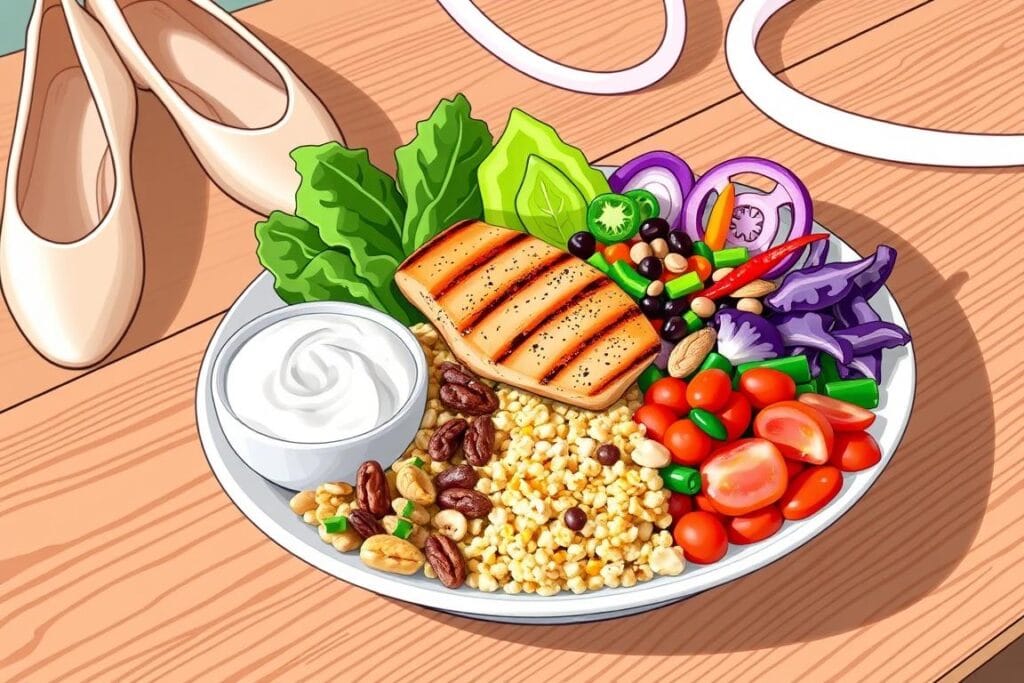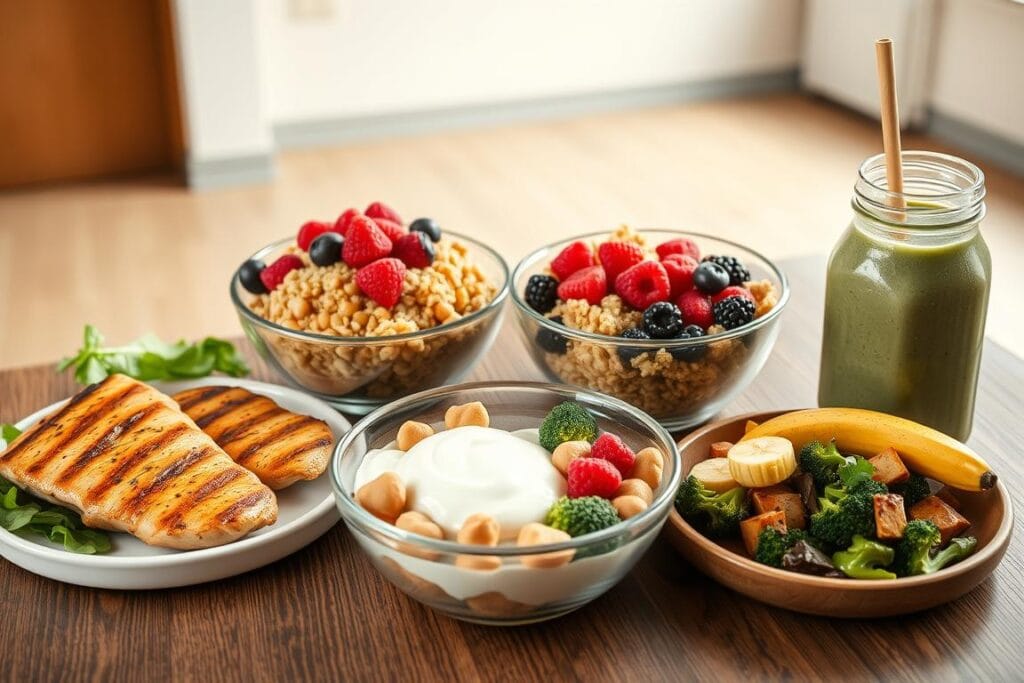Every pirouette, leap, and movement in choreography requires immense physical strength. Therefore, dancers understand that nutrition goes beyond providing energy. In fact, it forms the cornerstone of peak performance. Moreover, high-protein meals are essential because they support sustained energy, aid in muscle recovery, and enhance overall performance.
For this reason, dance nutrition involves a carefully planned approach to eating. Specifically, intense training and performances place significant stress on the body. Consequently, consuming protein-rich foods helps dancers maintain muscle health and reduces the risk of injury. As a result, the right nutrition becomes a transformative element in enhancing a dancer’s abilities.
At the same time, understanding dancer nutrition involves recognizing how dietary needs differ from those of other athletes. For example, protein plays a vital role not only in building muscle but also in meeting unique physical demands. Additionally, every dance style—whether ballet or contemporary—requires a specific nutritional approach. Thus, strategic eating ensures dancers remain strong, agile, and resilient.
In this guide, we will highlight the best high-protein meals to improve your performance. Furthermore, we will discuss effective nutritional strategies, meal planning tips, and ideal protein sources. Altogether, these insights will help dancers stay in peak condition while pursuing their passion for the art of dance.
Table of Contents
Understanding the Nutritional Needs of Dancers
Dance is a demanding physical art that needs the right nutrition. It’s not just about eating; it’s about fueling for top performance and recovery. Knowing what to eat is key for energy, strength, and health.

Dancers require a carefully tailored nutrition plan to support their unique physical demands. Therefore, choosing the best foods becomes essential for peak performance. Moreover, understanding the key nutrients that fuel dancers can unlock their full potential. Let’s explore the critical components that help dancers perform at their best.
The Role of Protein in Dance Performance
Protein is essential for dancers. It helps repair muscles, prevents injuries, and gives the body what it needs to perform well. Dancers use protein to:
- Rebuild muscle after hard workouts
- Keep muscle mass lean
- Speed up muscle recovery
- Boost strength and endurance
Daily Protein Requirements for Dancers
The amount of protein dancers need depends on how hard they train and their body type. Generally, dancers should aim for:
- 1.2 to 1.6 grams of protein per kilogram of body weight
- Eat protein throughout the day
- Choose high-quality, lean protein sources
Timing of Protein Intake for Optimal Results
When you eat protein matters a lot for dance performance. Ideal protein timing includes:
- Pre-workout: Light protein meal 1-2 hours before training
- Post-workout: Protein within 30 minutes after dance
- Evening: Slow-releasing protein for muscle recovery
By following these nutritional tips, dancers can improve their performance, avoid injuries, and stay in top shape.
Essential Protein Sources for Peak Dance Performance

Dancers rely on proper nutrition to maintain their peak performance. Therefore, understanding lean protein sources plays a vital role in supporting muscle repair and building strength. In addition, our guide highlights the best protein-rich foods, specifically designed to meet the needs of dancers.
Proteins for dancers can be divided into two main categories: animal-based and plant-based. Furthermore, each type offers unique benefits that directly enhance dance performance. For this reason, knowing how to balance these options is essential for achieving optimal results.
Animal Protein Powerhouses
- Chicken breast: Low-fat, high-protein option
- Greek yogurt: Packed with protein and probiotics
- Eggs: Complete protein with essential amino acids
- Lean fish: Salmon and tuna provide omega-3s
For dancers, eating a variety of proteins is important. Foods high in protein should have all amino acids for muscle repair and energy.
Plant-Based Protein Champions
- Quinoa: Complete protein source
- Lentils: High protein and fiber content
- Tofu: Versatile protein option
- Chickpeas: Nutrient-dense protein alternative
Dancers can improve their nutrition by eating different proteins. This supports their intense training.
What Are High Protein Meals for Dancers?
Dancers rely on proper meals to perform at their best and recover quickly. Therefore, including protein in their diet becomes essential for maintaining energy, repairing muscles, and staying fit. Moreover, we will explore high-protein meals specifically designed to meet the needs of dancers.

Dancers need special nutrition for their hard workouts. The right high protein meals can boost their performance and recovery.
Breakfast Options for Sustained Energy
Start your day with protein-rich breakfasts. Here are some great morning meals:
- Greek yogurt parfait with nuts and berries
- Egg white omelet with spinach and feta cheese
- Protein smoothie with whey or plant-based protein
- Overnight oats with chia seeds and almond butter
Lunch Combinations for Maximum Performance
What’s good for lunch for dancers? Look for meals that give energy without making you feel slow:
- Grilled chicken quinoa bowl
- Salmon salad with mixed greens
- Turkey and hummus wrap
- Tofu stir-fry with brown rice
Dinner Ideas for Recovery and Repair
Dinner for dancers should help with muscle repair and energy. Choose lean proteins, complex carbs, and veggies:
- Lean beef with roasted sweet potato
- Baked fish with quinoa and steamed broccoli
- Grilled turkey breast with mixed vegetable medley
- Lentil and vegetable protein bowl
Our suggested high protein meals for dancers offer balanced nutrition. They support tough training and performance. Adjust meal sizes based on your energy needs and dance level.
Quick and Easy High-Protein Meal Prep Ideas
Dancers benefit from smart nutrition plans that align with their demanding schedules. Therefore, incorporating meal prep into your routine can enhance your training nutrition while saving valuable time. Moreover, we’ll guide you on maintaining high energy levels and fueling your muscles effectively.
Our top meal prep tips focus on creating energy-boosting meals that are also portable. Additionally, the key to success lies in batch cooking and planning meals ahead of time. As a result, dancers can stay nourished and prepared for their busy days.
- Protein-packed mason jar salads with grilled chicken
- Overnight chia seed puddings with protein powder
- Hard-boiled eggs with pre-cut vegetable sticks
- Quinoa and black bean meal prep bowls
High-protein snacks for dancers should be easy to take with you and full of nutrients. We suggest making snacks that you can grab and go, helping you stay strong during long days of training.
- Greek yogurt with mixed nuts
- Protein smoothie packs
- Turkey and hummus roll-ups
- Protein energy balls
Spending just 2-3 hours on weekends can get you ready for the week. Use clear sections in your fridge and label containers with what’s inside and when you made it. This way, you’ll always have healthy meals ready to go, supporting your dance performance.
Plant-Based Protein Options for Dancers
Dancers on vegetarian or vegan diets can get enough protein with the right plan. Plant-based proteins are great for dancers looking to perform better and recover faster.
Complete Protein Sources for Vegetarian Dancers
Vegetarian dancers need to pick their proteins wisely. Here are some top choices:
- Quinoa: A grain packed with all nine essential amino acids
- Tempeh: Fermented soybean protein that’s easy for the body to use
- Seitan: Made from wheat, it’s very high in protein
- Nutritional yeast: Offers complete protein and vitamin B12
Combining Plant Proteins Effectively
Plant proteins work better together. By mixing different types, dancers can get a complete protein profile. This helps build muscle and gives energy.
- Rice and beans
- Hummus with whole grain bread
- Lentils with nuts
- Spirulina with seeds
Vegan Meal Planning for Dancers
Our vegan options focus on balanced, nutrient-rich meals. Good meal planning helps dancers get enough protein for their hard workouts.
- Make protein-rich smoothies
- Try protein-packed overnight oats
- Enjoy diverse grain and legume bowls
- Use protein supplements if needed
Dancers can do well on plant-based diets with the right nutrition plan and variety of proteins.
Pre-Performance Protein-Rich Meals
Dancers understand that the right food can make a big difference in their performances. Good nutrition before a show is key to keeping energy up and supporting the body’s needs.
Choosing the right meal before a dance is very important. We suggest meals rich in protein to give dancers energy that lasts. This way, dancers can perform at their best without feeling heavy.
- Timing is everything: Eat a protein-rich meal 2-3 hours before performance
- Select lean proteins that digest easily
- Balance protein with complex carbohydrates
Here are some top protein options for dancers:
- Greek yogurt with berries
- Grilled chicken with quinoa
- Egg white and spinach omelet
- Protein smoothie with banana
Our nutrition plan helps dancers get the best fuel without feeling tired. Light, nutritious meals keep dancers at their best. They support muscle readiness and energy.
Keep in mind, everyone’s body is different. Try different foods to find what works best for you.
Post-Training Recovery Meals and Snacks
Dance training is very demanding, making what you eat after very important. It helps your muscles recover and keeps you performing well. Eating right can help you get back to your best faster.
Immediate Post-Dance Nutrition Strategies
The first 30 minutes after dancing are key for recovery. Your body needs quick energy and muscle repair. High-protein snacks are essential during this time.
- Greek yogurt with berries
- Protein smoothie with banana
- Hard-boiled eggs with whole grain toast
- Chocolate milk (natural protein recovery drink)
Long-Term Recovery Meal Planning
Planning your meals after dance is important for long-term recovery. A balanced diet with lean proteins, complex carbs, and nutrients is best. It supports your training needs.
- Consume protein within 45 minutes of performance
- Include varied protein sources
- Stay hydrated
- Monitor overall nutrient intake
Using these strategies, dancers can improve their performance, lessen soreness, and keep their energy up. This is key for consistent, top-level training.
Common Protein Myths in Dance Nutrition
Dancer nutrition myths can really affect how well dancers perform and stay healthy. It’s important for dancers to know the truth about protein. Many dancers get confused about what they should eat for protein.
Let’s look at some common protein myths dancers face:
- Myth: Protein Makes Dancers Bulky
Dancers often worry that protein will make them too big. But, protein helps keep muscles lean and prevents injuries. - Myth: All Protein Sources Are Equal
Not all proteins are the same. Dancers need complete proteins to help their muscles recover and give them energy. - Myth: More Protein Means Better Performance
Having too much protein doesn’t always mean better dance skills. It’s more about the quality and balance of what you eat.
So, what do dancers eat for protein? They focus on high-quality protein sources. This includes lean meats, plant-based proteins, and well-planned meals.
Knowing the truth about these myths helps dancers make better food choices. Protein is key for dancers, but it’s important to know how to use it right.
Balancing Protein with Other Nutrients for Dancers
Dancer nutrition is more than just protein. It’s about finding the right mix of nutrients for top performance and health.
Knowing what dancers should eat means looking beyond protein. Our bodies need a full nutritional plan for intense workouts and recovery.
Carbohydrate and Protein Ratio
Dancers need the right mix of carbs and proteins for energy and muscle repair. The best ratio is:
- 3-4 grams of carbs for every 1 gram of protein
- Time meals with workouts and shows
- Choose complex carbs for lasting energy
Incorporating Healthy Fats
Healthy fats are key for dancers. Omega-3 fatty acids and monounsaturated fats help with joint health, reduce swelling, and give energy for tough routines.
- Avocados
- Nuts and seeds
- Olive oil
- Fatty fish
Micronutrient Considerations
Dancers should focus on micronutrients for muscle and bone health. Important nutrients include:
- Calcium for strong bones
- Iron to fight tiredness
- Vitamin D for muscle strength
- Magnesium for muscle healing
With a balanced diet, dancers can perform better, avoid injuries, and stay in top shape.
Conclusion
Finding the right high protein meals for dancers is all about planning and knowing what you need. It’s not just about eating food; it’s about fueling your body for performance and recovery. This helps dancers stay in top shape.
So, what are these high protein meals for dancers? They’re about finding the right balance of nutrients for their intense dance routines. By eating a variety of proteins, dancers can boost their energy and repair muscles better.
It’s clear that each dancer needs a nutrition plan that fits them alone. This means paying attention to how much protein they eat, when, and what else they consume. Whether it’s meat or plants, the aim is to improve strength and artistry.
As dancers strive to reach new heights, good nutrition is more important than ever. We’ve shown how to choose the best protein-rich meals. This helps dancers improve their skills and artistry.
FAQ
How much protein do dancers need daily?
Dancers need 1.2 to 2.0 grams of protein for every kilogram of body weight. This depends on how hard they train. For most, it’s about 15-25% of their daily calories. This helps with muscle recovery, strength, and performance.
What are the best protein sources for dancers?
Lean proteins like chicken, turkey, fish, eggs, and Greek yogurt are great. Tofu, legumes, and quinoa are also good. Plant-based dancers can mix beans, lentils, and nuts for complete proteins. Choose foods that are easy to digest and full of nutrients.
Can vegetarian dancers get enough protein?
Yes! Vegetarian dancers can achieve complete proteins by combining different plant-based foods. For instance, beans and rice, hummus with whole-grain bread, and quinoa with legumes serve as excellent options. Moreover, adding Greek yogurt and cottage cheese boosts protein intake. Therefore, planning meals carefully ensures they consume enough protein to meet their needs.When is the best time to consume protein for dancers?
Protein is key before and after workouts. Eat protein within 30 minutes after working out to help muscles recover. A balanced meal 2-3 hours before a performance should have some protein. This gives energy without feeling too full.
Are protein supplements recommended for dancers?
Whole foods are best, but protein powders can help dancers with busy schedules. Whey, plant-based, or casein proteins can add to what you eat. But, don’t forget to eat real food too.
How do vegan dancers ensure complete protein intake?
Vegan dancers can obtain all essential amino acids by combining different plant proteins. For example, quinoa, tempeh, seitan, nutritional yeast, and legume-grain combinations provide excellent options. Additionally, eating a variety of plant-based proteins ensures a complete amino acid profile. Consequently, variety remains crucial for meeting nutritional needs.What are quick high-protein snacks for dancers?
Good snacks include hard-boiled eggs, Greek yogurt, and protein smoothies. Edamame, nut butter with apple slices, turkey roll-ups, and protein bars are also good. These snacks give energy and help muscles recover between rehearsals.
Can too much protein be harmful for dancers?
Too much protein can harm the kidneys and lead to dehydration. Therefore, dancers should aim for a balanced protein intake. This goal depends on their body weight, training routines, and nutritional needs. Furthermore, consulting a sports nutritionist can help determine the proper amount.

